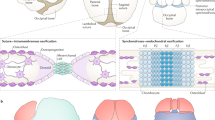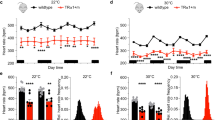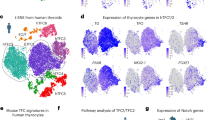Abstract
Congenital thyroid disorders are often associated with profound deafness, indicating a requirement for thyroid hormone (T3) and its receptors in the development of hearing1–5. Two T3 receptor genes, Trα and Trβ6,7, are differentially expressed, although in overlapping patterns, during development8–11. Thus, the extent to which they mediate unique or redundant functions is unclear. We demonstrate that Trβ-deficient (Thrb−/−) mice12 exhibit a permanent deficit in auditory function across a wide range of frequencies, although they show no other overt neurological defects. The auditory-evoked brainstem response (ABR) in Thrb−/− mice, although greatly diminished, displayed normal waveforms, which suggested that the primary defect resides in the cochlea. Although hypothyroidism causes cochlear malformation13,14, there was no evidence of this in Thrb−/− mice. These findings suggest that Trβ controls the maturation of auditory function but not morphogenesis of the cochlea. Thrb−/− mice provide a model for the human endocrine disorder of resistance to thyroid hormone (RTH), which is typically associated with dominant mutations in Trβ12,15. However, deafness is generally absent in RTH, indicating that dominant and recessive mutations in Trβ have different consequences on the auditory system. Our results identify Trβ as an essential transcription factor for auditory development and indicate that distinct Tr genes serve certain unique functions.
This is a preview of subscription content, access via your institution
Access options
Subscribe to this journal
Receive 12 print issues and online access
$209.00 per year
only $17.42 per issue
Buy this article
- Purchase on Springer Link
- Instant access to full article PDF
Prices may be subject to local taxes which are calculated during checkout
Similar content being viewed by others
References
Pendred, V. Deaf-mutism and goitre. Lancet. 532 (1896).
McCarrison, R. Observations of endemic cretinism in the Chitral and Gilgit valleys. Lancet. 1275–1280 (1908).
Refetoff, S., DeWind, L.T. & DeGroot, L.J. Familial syndrome combining deaf-mutism, stippled epiphyses, goiter, and abnormally high PBI: possible target organ refractoriness to thyroid hormone. J. Clin. Endocrinol. Metab. 27, 279–294 (1967).
Stanbury, J.B. The pathogenesis of endemic cretinism. J. Endocrinol. invest. 7, 409–419 (1984).
DeLong, G.R. Effects of nutrition on brain development in humans. Am. J. Clin. Nutr. Suppl. 57, 286S–290S (1993).
Sap, J. et al. The c-erbA protein is a high affinity receptor for thyroid hormone. Nature 324, 635–640 (1986).
Weinberger, C., Thompson, C.C., Ong, E.S., Lebo, R., Gruol, D.J. & Evans, R.M. The c-erb-A gene encodes a thyroid hormone receptor. Nature. 324, 641–646 (1986).
Forrest, D., Sjöberg, M. & Vennström, B. Contrasting developmental and tissue-specific expression of α and β thyroid hormone receptor genes. EMBO J. 9, 1519–1528 (1990).
Strait, K.A., Schwartz, H.L., Perez-Castillo, A. & Oppenheimer, J.H. Relationship of c-erbA mRNA content to tissue triiodothyronine nuclear binding capacity and function in developing and adult rats. J. Biol Chem. 265, 10514–10521 (1990).
Bradley, D.J., Towle, H.C. & Young, W.S. α and β thyroid hormone receptor (TR) gene expression during auditory neurogenesis: evidence for TR isoform-specific transcriptional regulation in vivo. Proc. Natl. Acad. Sci. USA 91, 439–443 (1994).
Forrest, D. The erbA/thyroid hormone receptor genes in development of the central nervous system. Semin. Cancer Biol. 5, 167–176 (1994).
Forrest, D. et al. Recessive resistance to thyroid hormone in mice lacking thyroid hormone receptor β: evidence for tissue-specific modulation of receptor function. EMBO J. (in the press).
Deol, M.S. An experimental approach to the understanding and treatment of hereditary syndromes with congenital deafness and hypothyroidism. J. Med. Genet. 10, 235–242 (1973).
Uziel, A., Gabrion, J., Ohresser, M. & Legrand, C. Effects of hypothyroidism on the structural development of the organ of Corti in the rat. Acta Otolar. 92, 469–480 (1981).
Refetoff, S., Weiss, R.E. & Usala, S.J. The syndromes of resistance to thyroid hormone. Endocrine Rev. 14, 348–399 (1993).
Erway, L.C., Willott, J.F., Archer, J.R. & Harrison, D.E. Genetics of age-related hearing loss in mice: I. Inbred and F1 hybrid strains. Hearing Res. 65, 125–132 (1993).
Steel, K.P. & Brown, S.D.M. Genes and deafness. Trends Genet. 10, 428–435 (1994).
Hébert, R., Langlois, J.-M. & Dussault, J.H. Permanent defects in rat peripheral auditory function following perinatal hypothyroidism: determination of a critical period. Dev. Brain Res. 23, 161–170 (1985).
Uziel, A. Periods of sensitivity to thyroid hormone during the development of the organ of Corti. Acta Otolar. (Stockh) 429, 23–27 (1986).
Freeman, S., Geal-Dor, M., Shimoni, Y. & Sohmer, H. Thyroid hormone induces earlier onset of auditory function in neonatal rats. Hearing Res. 69, 229–235 (1993).
Morreale de Escobar, G., Obregon, M.J., Calvo, R., & Escobar del Ray, F. in Advances in Perinatal Thyroidology. (eds. Bercu, B.B. & Shulman, D.I.) 133–156 (Plenum Press, New York, 1991).
Burrow, G.N., Fisher, D.A. & Larsen, P.R. Maternal and fetal thyroid function. N. Eng. J. Med. 331, 1072–1078 (1994).
Deol, M.S. The role of thyroxine in the differentiation of the organ of Corti. Acta Otolar. 81, 429–435 (1976).
Meyerhoff, W.L. Hypothyroidism and the ear: electrophysiological, morphological, and chemical considerations. Laryngoscope 89, 1–25 (1979).
Hébert, R. et al. Auditory brainstem response audiometry in congenially hypothyroid children under early replacement therapy. Pediatr. Res. 20, 570–573 (1986).
Anand, V.T., Mann, S.B.S., Dash, R.J. & Mehra, Y.N. Auditory investigation in hypothyroidism. Acta Otolar. (Stockh) 108, 83–87 (1989).
O'Malley, B.W., Li, D. & Turner, D.S. Hearing loss and cochlear abnormalities in the congenital hypothyroid (hyt/hyt) mouse. Hearing Res. 88, 181–189 (1995).
Takeda, K., Sakurai, A., DeGroot, L.J. & Refetoff, S. Recessive inheritance of thyroid hormone resistance caused by complete deletion of the protein-coding region of the thyroid hormone receptor-β gene. J. Clin. Endocrinol. Metab. 74, 49–55 (1992).
Brucker-Davis, F. et al. Genetic and clinical features of 42 kindreds with resistance to thyroid hormone. Ann. Intern. Med. 123, 572–583 (1995).
Damm, K., Thompson, C.C. & Evans, R.M. Protein encoded by v-erbA functions as a thyroid-hormone receptor antagonist. Nature 339, 593–597 (1989).
Sjöberg, M. & Vennström, B. Ligand-dependent and -independent transactivation by thyroid hormone receptor β2 is determined by the structure of the hormone response element. Mol. Cell. Biol. 15, 4718–4726 (1995).
Chen, J.D. & Evans, R.M. A transcriptional co-repressor that interacts with nuclear hormone receptors. Nature 377, 454–458 (1995).
Hörlein, A.J. et al. Ligand-independent repression by the thyroid hormone receptor mediated by a nuclear receptor co-repressor. Nature 377, 397–404 (1995).
Corey, D.R. & Breakefield, X.O. Transcription factors in inner ear development. Proc. Natl. Acad. Sci. USA. 91, 433–436 (1994).
Author information
Authors and Affiliations
Corresponding author
Rights and permissions
About this article
Cite this article
Forrest, D., Erway, L., Ng, L. et al. Thyroid hormone receptor β is essential for development of auditory function. Nat Genet 13, 354–357 (1996). https://doi.org/10.1038/ng0796-354
Received:
Accepted:
Issue Date:
DOI: https://doi.org/10.1038/ng0796-354
This article is cited by
-
Maternal thyroid hormone receptor β activation in mice sparks brown fat thermogenesis in the offspring
Nature Communications (2023)
-
Deficiency of thyroid hormone receptor protects retinal pigment epithelium and photoreceptors from cell death in a mouse model of age-related macular degeneration
Cell Death & Disease (2022)
-
Evaluation of Hearing Loss in Congenital Hypothyroid Children at a Tertiary Care Hospital in Central India
Indian Journal of Otolaryngology and Head & Neck Surgery (2022)
-
Exacerbated age-related hearing loss in mice lacking the p43 mitochondrial T3 receptor
BMC Biology (2021)
-
Thyroid hormone receptor beta is critical for intestinal remodeling during Xenopus tropicalis metamorphosis
Cell & Bioscience (2020)



